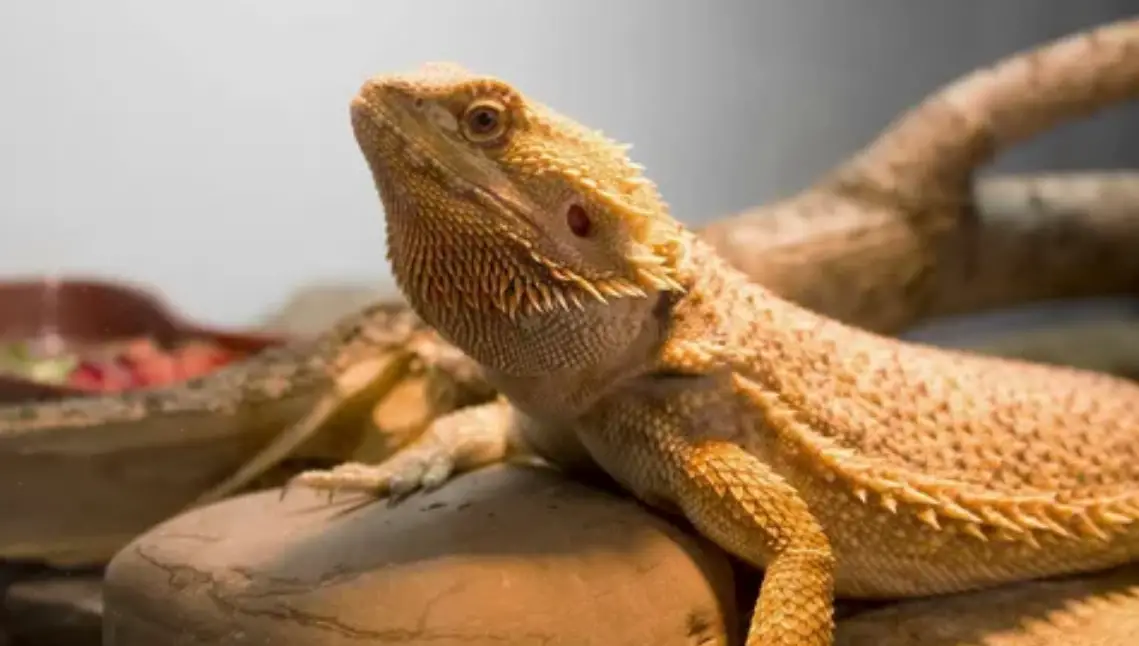When you bring a reptile into your home, you should be well-prepared to provide for its needs. Taking care of reptiles can be challenging since they have unique requirements. A few pointers can keep you on track, so continue reading to assess your progress.
- 1. Start with some Basic Investigations
- 2. Employ a Superb Habitat
- 3. Locate an Experienced Veterinarian Specializing in Reptiles
- 4. Regularly changing out UVB Light Bulbs
- 5. Explore the Food Habits
- 6. Learn the Proper Places to Pet Your Reptile
- 7. Wash your hands before touching them
- 8. Remove Any Head Restraints Before Leaving Home
- 9. Communicate to your reptile when it’s not food time
- 10. Take Temperature into Consideration
- 11. Take Care in High Humidity
- 12. Take Care with the Lights
- 13. Wait for the Pet Food to Settling
- 14. Keep an eye on kids whenever they’re around a reptile
- 15. Maintain a Tidy Habitat for the Reptile
- 16. Don’t Stop Learning
- 17. Locate Communal Support System
- Final Thoughts

In this article, you’ll learn about some interesting suggestions needed for your pet reptile’s care. So, stay with us till the end.
1. Start with some Basic Investigations
To make it effective as a reptile owner, it is important to complete your research before getting started. The requirements of one reptile species may not be suitable for another.
Knowing and being able to provide for your reptile’s unique characteristics and requirements is essential to ensuring its health and happiness before you bring it home.
Your lack of dedication disqualifies you as a potential reptile owner. Before deciding, you should research its feeding schedule, preferred foods, and other demands.
2. Employ a Superb Habitat
When it comes to breaking free of their enclosures, reptiles, and especially snakes, can prove to be rather resourceful. They will utilize all means at their disposal to go outside and “investigate.” That’s an extremely risky idea for the pet owner.
Good reptile cages are important for providing a healthy home for your new reptiles. It’s important to make sure your terrarium is easy to access but secure enough that your pet can’t get out.
Don’t fall for the trap of a cage that will free your pet without your knowledge because one of those traits is typically lacking in the cheaper entry-level kits provided for terrariums.
3. Locate an Experienced Veterinarian Specializing in Reptiles
One should have a vet in mind before picking the right pet and bringing it into the family. Find one quickly, as there are several that focus on the more common reptile species used as pets. Of course, a lot of people fail to do this at the start and then find themselves pressed for time.
Bring your reptile in for frequent checkups at the vet, just like you would with a dog or cat. It is possible to alter the reptile’s habitat to fix many of these issues. It’s easy for an inexperienced keeper to mess up the setup, even if they do their homework.
Don’t skip it because of the cost, though. It’s crucial, especially considering how many caged reptiles have tragically short lifespans despite their owners’ best efforts.
4. Regularly changing out UVB Light Bulbs
Typically, UVB light bulbs have a lifespan of over a year. Still, a once-a-year replacement is required.
A reptile’s health depends on its exposure to ultraviolet B radiation. By simulating the sun’s UV rays, it aids in keeping them in good condition and overall wellness.
This variety is safer for people, but without it, reptiles will experience severe health problems.
Over time, the bulbs will inevitably fail. It’s vital to note that the UVB disappears first when the spectrum narrows and the bulb burns out. Since replacement UVB bulbs are cheap, it’s a good idea to do so.
5. Explore the Food Habits
Many reptiles eat a wider variety of foods than we give them credit for. The diets of our scaly friends can consist of more than just crickets, wax worms, and mice.
Learn what your pets need to eat by doing some research. While some people might get by just fine with a dusting of calcium powder on their bugs, others might have more specific requirements.
Many people make the mistake of denying certain animals access to greenies, which is a huge mistake. Herbivorous reptiles are no exception to the rule that many reptiles have quite complicated diets. If you want your animal to have a long, healthy life, you need to do your homework.
What you need to cook for them should be on hand, as well. A cricket breeding cage, worm breeding spots, or even a blender for herbivores can simplify your life. Acquire them without delay.
6. Learn the Proper Places to Pet Your Reptile
You should never grab a lizard or snake by the tail and haul it around or remove it from its cage. The animal’s natural defense mechanisms will be triggered since the lack of physical support will cause them tension and anxiety.
7. Wash your hands before touching them
The sensory systems of reptiles are exceptionally developed. Because of this, they are able to pick up even the tiniest odors.
A reptile may mistake your hand for prey if it still bears traces of the fragrance of the animal you were hunting.
To avoid getting bitten, always wash your hands after handling the species you feed your pet. Keeping clean hands when handling your reptile is another way to avoid spreading germs and other unwanted substances in its habitat.
8. Remove Any Head Restraints Before Leaving Home
Using a head restraint on your reptile pet is nearly sure to be interpreted as a predatory move by your pet. Your pet will learn to dread you, and that will make a life together miserable for you.
9. Communicate to your reptile when it’s not food time
Snakes and other reptiles only bite in two situations: when they are hungry or when they are trying to defend themselves. Make sure your pet knows it’s not feeding time before picking it up.
You can either hook it out of its cage or gently poke its snout with an inanimate object to get it to come out. With these moves, you can “break the hunt” and show the snake that you are not a threat.
10. Take Temperature into Consideration
Ectotherms, like reptiles, control their internal temperatures with the help of their environment. Reptiles can’t survive in most indoor environments because the temperature is too low.
This means that it’s not good for your pet to be removed from its terrarium for extended periods of time. Exposure times outside the cage should be kept to 30 minutes or less to ensure your reptile maintains a healthy body temperature.
In addition, a herpetologist or the staff at your local pet store can tell you whether or not a heat lamp or other equipment is necessary for keeping your reptile at a comfortable temperature.
11. Take Care in High Humidity
Carefully managing the humidity level in your reptile’s enclosure is essential to the animal’s well-being. Reptiles and amphibians are susceptible to fatal health issues in arid habitats.
Contaminating bacteria and fungi thrive in damp places. Burrowing or relocating to a different microclimate where the humidity is lower allows reptiles this degree of control in the wild. They are unable to do this while in captivity, so it is your responsibility to assist them.
12. Take Care with the Lights
Proper lighting is also essential for the health of your reptile pet. Being cold-blooded, their survival depends on the day-night cycle and the warmth from the sun. Because of this, making sure your reptile has access to adequate lighting is crucial to its well-being.
13. Wait for the Pet Food to Settling
When a meal takes a reptile more than a day to digest, the abdominal organs undergo a lot of strain. Regurgitation can be dangerous to your reptile if you handle it too much while it is trying to digest food. If your pet has a noticeable bulge in its stomach, you should limit your contact with it.
14. Keep an eye on kids whenever they’re around a reptile
Always keeping an eye on kids who are playing with a reptile is a must for everyone’s safety. A child’s rough treatment of the animal risks the animal’s faith in humans. Children can be frightened by reptiles because they can bite, scratch, or whip their tails if they go into defense mode.
Also, because their immune systems are not fully formed, children under the age of 18 months should never be allowed to handle a reptile.
15. Maintain a Tidy Habitat for the Reptile
You must be willing to maintain a spotless enclosure for your reptile. When reptiles are kept in dirty conditions, they might develop skin bacterial infections. Additionally, salmonella, which is hazardous to humans, can be found in their feces. To avoid either of these problems, it is important to keep your reptile’s cage clean and disinfect it on a regular basis.
16. Don’t Stop Learning
A pet owner with knowledge is a pet owner with intelligence. All reptiles carry the potential for harm. To protect yourself and your loved ones, it’s important to be aware of potential threats and take the necessary precautions. Never let your pride get in the way. This is not the right pet for you if you lack the self-assurance necessary to care for a reptile.
17. Locate Communal Support System
You need to find people who share your interests and values. Almost any animal you might encounter will be cared for by a team of experts so someone can answer your questions instantly. Sharing photos of your pet is also a lot of fun.
Final Thoughts
Caring for pet reptiles requires knowledge, dedication, and commitment. If you can provide a suitable environment, proper nutrition, and regular health checks then your pet reptile may remain happy and healthy for years to come. So follow above mentioned interesting tips on how to care for pet reptiles and become a responsible reptile owner.


